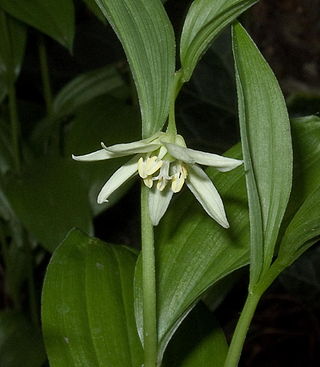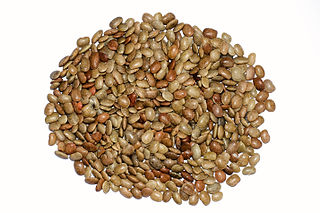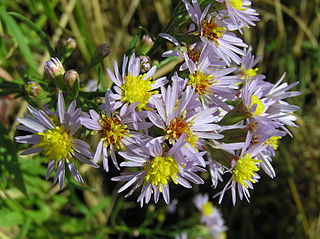
Solanum is a large and diverse genus of flowering plants, which include three food crops of high economic importance: the potato, the tomato and the eggplant. It is the largest genus in the nightshade family Solanaceae, comprising around 1,500 species. It also contains the so-called horse nettles, as well as numerous plants cultivated for their ornamental flowers and fruit.

The flowering plant genus Ipheion belongs to Allioideae, a subfamily of the family Amaryllidaceae. It includes three species native to southern Brazil, northeastern Argentina, and Uruguay.

Leptosema is a genus of flowering plants from the legume family Fabaceae. According to the Australian Plant Census, species of Leptosema occur in the Northern Territory, Western Australia, South Australia and Queensland.

Fallopia is a genus of about 12 species of flowering plants in the buckwheat family, often included in a wider treatment of the related genus Polygonum in the past, and previously including Reynoutria. The genus is native to temperate and subtropical regions of the Northern Hemisphere, but species have been introduced elsewhere. The genus includes species forming vines and shrubs.

Stylidium is a genus of dicotyledonous plants that belong to the family Stylidiaceae. The genus name Stylidium is derived from the Greek στύλος or stylos, which refers to the distinctive reproductive structure that its flowers possess. Pollination is achieved through the use of the sensitive "trigger", which comprises the male and female reproductive organs fused into a floral column that snaps forward quickly in response to touch, harmlessly covering the insect in pollen. Most of the approximately 300 species are only found in Australia, making it the fifth largest genus in that country. Triggerplants are considered to be protocarnivorous or carnivorous because the glandular trichomes that cover the scape and flower can trap, kill, and digest small insects with protease enzymes produced by the plant. Recent research has raised questions as to the status of protocarnivory within Stylidium.

Cylindropuntia is a genus of cacti, containing species commonly known as chollas, native to northern Mexico and the Southwestern United States. They are known for their barbed spines that tenaciously attach to skin, fur, and clothing. Stands of cholla are called cholla gardens. Individuals within these colonies often exhibit the same DNA, as they were formerly tubercles of an original plant.

Calandrinia is a genus of flowering plants known as purslanes and redmaids. It includes 37 species of annual and perennial herbs which bear colorful flowers in shades of red to purple and white. Species of this genus are native to the Americas, including western and southern South America, Central America, and western North America. Some species have been introduced to parts of Australia, New Zealand, southern Africa, Asia, and Europe. Over 60 species native to Australia and New Guinea that were formerly included in Calandrinia are now placed in a separate genus, Rumicastrum or Parakeelya. A single eastern Australian species named in 2022, Calandrinia petrophila, is still included in Calandrinia, but will be placed into the Australian genus when the name of the new genus is finally settled.

Solanum elaeagnifolium, the silverleaf nightshade or silver-leaved nightshade, is a species of plant in the nightshade family native to North and South America. It is common in parts of southwestern USA, and sometimes weed of western North America. Other common names include prairie berry, silverleaf nettle, white horsenettle or silver nightshade. In South Africa it is known as silver-leaf bitter-apple or satansbos. More ambiguous names include "bull-nettle", "horsenettle" and the Spanish "trompillo".

Disporum is a genus of about 20 species of perennial flowering plants, found in Asia from northern India to Japan, south to Indonesia and north into the Russian Far East.

Macrotyloma is a genus of plants in the legume family which include several species of edible beans. Some species are also used as fodder for livestock.

Ipheion uniflorum is a species of flowering plant, related to the onions, placed in the allium subfamily (Allioideae) of the Amaryllidaceae. It is known by the common name springstar, or spring starflower. Along with all the species of the genus Ipheion, some sources place it in the genus Tristagma, but research published in 2010 suggested that this is not correct. It is native to Argentina and Uruguay, but is widely cultivated as an ornamental and reportedly naturalized in Great Britain, France, Australia, New Zealand and the United States.

Geocarpon groenlandicum, the Greenland stitchwort or mountain stitchwort, Appalachian stitchwort, mountain sandwort, smooth mountain sandwort, and smooth sandwort is a rare perennial which grows low to the ground in clumps linked together at the bottom. It has three to five pairs of leaves in a linear opposite pattern along the length of the slender stem. The main stem breaks into one to thirty cymes which each flower separately. The flowers are white and arise five to ten centimeters above the thick foliage. The white flower petals are six to ten millimeters long. The petals are, in turn, surrounded by five green sepals.

Tripolium is a genus of Eurasian and North African plants in the tribe Astereae within the family Asteraceae.

Geocarpon minimum is a species of flowering plant in the carnation family (Caryophyllaceae) which is known by the common names tinytim and earth-fruit. It is a rare plant known from about 34 populations in the US states of Arkansas, Louisiana, Missouri, and Texas. There are a number of threats to its survival and it was listed as a threatened species of the United States in 1987.

Trichophorum is a genus of flowering plants in the sedge family, Cyperaceae. Plants in this genus are known as deergrasses in Britain but are sometimes known as bulrushes in North America.

Baeometra is a genus in the family Colchicaceae containing a single species, Baeometra uniflora. It is native to South Africa, where it is commonly called beetle lily due to the dark markings on the tepals.
Galium uniflorum, common name oneflower bedstraw, is a species of plants in the Rubiaceae. It is native to the southeastern United States from eastern Texas to Maryland.

Geocarpon glabrum, commonly called Appalachian stichwort, is a species of flowering plant in the carnation family (Caryophyllaceae). It is native to the eastern United States, where it has a scattered distribution.
Argyrolobium uniflorum is a wild pluriannual herbaceous species of drought tolerant legume found in arid regions of Northern Africa sometimes described as pseudo-savannah. A. uniflorum is a hardy wild species of plant and it is considered a valuable forage crop for agriculture in Africa. It is also useful as a potentially important species in bioremediation and dryland restoration in arid regions of Tusinia which are sensitive to misappropriation and overgrazing.
















